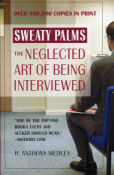| What REALLY goes on in a job interview? Find out in the new revision of "Sweaty Palms: The Neglected Art of Being Interviewed" (Warner Books) by Tony Medley, updated for the world of the Internet . Over 500,000 copies in print and the only book on the job interview written by an experienced interviewer, one who has conducted thousands of interviews. This is the truth, not the ivory tower speculations of those who write but have no actual experience. "One of the top five books every job seeker should read," says Hotjobs.com. | |
| The Nativity Story (10/10) by Tony Medley This is an amazingly faithful rendition of the story of the birth of Jesus as told in the Gospels of St. Matthew and St. Luke without being too gushingly devout. In 102 mesmerizing minutes, it recreates that world with what appears to be admirable accuracy (although, I admit, I wasn't actually there at the time). Regular readers of this column will be shocked to learn that I found little to criticize. To anybody who attended Catholic grammar school, this will be a lovingly familiar story (anybody but Bill O’Reilly, I mean; Bill claimed decades of Catholic school education and then spouted to the world saying that the Immaculate Conception was the virgin birth. Exacerbating the misinformation he disseminated to millions of people who trust him, he then refused to correct it. In fact, the Immaculate Conception refers to Mary being conceived without the stain of Original Sin and has nothing to do with the birth or conception of Jesus, but you wouldn’t know it by listening to Bill and Judge funnyhair (Napolitano), both of whom claim something like three decades of Catholic education between them. Bill will probably see this film and wonder why they didn’t name it “The Story of the Immaculate Conception”). But I digress. This movie, which is so good it got an ovation at a media screening, something that usually only occurs at virulently leftwing films, is a realistic, faithful telling of how Mary and Joseph came to be at that stable in Bethlehem where Mary gave birth to Jesus. There are lots of things I liked about this film. The first is that Mary (Keisha Castle-Hughes, who made such a smashing debut in “Whale Rider, 2002) looks like she’s a young woman of around 15, which is what Mary was supposed to be when Jesus was born. She is far and away the best Mary ever to appear on film. Joseph (Oscar Isaac) looks to be in his young 20s. I always pictured him as much older, like 35. The ambience of the film looks like it is right on. The poverty of the people is captured with clarity; the villages look like they must have looked 2,000 years ago. Bethlehem, in particular, looks like something I’ve never imagined, but is probably pretty accurate. And the stable in which Jesus is born is also something that doesn’t look like what we see on Christmas Day, but is probably just exactly the way it was, filled with sheep and no furniture, except the manger which becomes Jesus’ first bed. Mike Rich’s script is rich in speculation. We know virtually nothing about Mary’s life and parents, and even less about Joseph, so Rich has created a story line that fills in perfectly with what we know from the Gospels. The lines he has Mary say to the Angel Gabriel that we know as the beautiful prayer The Magnificat are spoken with such every day realism that you don’t really recognize that you are hearing a famous prayer until you think about it. This emphasizes the strength of the film. Rich and Director Catherine Hardwicke make Mary and Joseph and everyone else real people, not cardboard saints with halos around their heads. They are just simple people struggling to make it through a very tough life. Even after the extraordinary events start to occur, they take them more or less in stride. Most movies need a bad guy, and Ciaran Hinds creates a wonderful one as Herod, the ruler who is so worried about the Messiah that he kills 40 little boys in Bethlehem 2 years-old and under. One of the better things that Rich has done is spend quite a bit of time on Joseph. He is as much a character in the film as Mary, and he’s the guy who steps up and gets everything done. The Gospels kind of ignore poor Joseph, but he had to be the type of man we see in this film in order to get done what had to be done. Unlike Mr. O’Reilly, I paid attention in grammar school and know the story of the Nativity like the back of my hand. I can see nothing to criticize in Rich’s script. As to Hardwicke’s direction, it was superb, except for one scene. I didn’t much like the ray of light she had pointing directly on the manger from the star that led the Wise Men to the stable. That was a little too miraculously over the top for a film that in all other aspects seems deadly accurate and matter-of-fact. In fact, I think that Hardwicke has directed a masterpiece here. For anyone who isn’t that familiar with what Christmas is and only thinks of it as a Nativity scene and a time to exchange presents and take a holiday, this is a must see. For Christians who know the story, they will be heartened to find that Hollywood has treated it with respect and not changed a hair on the basic story’s head while amplifying what we don’t know with intelligent speculation. November 29, 2006
|
|
|
|
|
